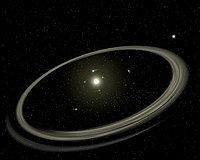
Photo from wikipedia
Present Address Leibniz Institute for Astrophysics (AIP) An der Sternwarte 16, 14482 Potsdam, Germany Coronal mass ejections (CMEs) are more energetic than any other class of solar phenomena. They arise… Click to show full abstract
Present Address Leibniz Institute for Astrophysics (AIP) An der Sternwarte 16, 14482 Potsdam, Germany Coronal mass ejections (CMEs) are more energetic than any other class of solar phenomena. They arise from the rapid release of up to 1033 erg of magnetic energy mainly in the form of particle acceleration and bulk plasma motion. Their stellar counterparts, presumably involving much larger energies, are expected to play a fundamental role in shaping the environmental conditions around low-mass stars, in some cases perhaps with catastrophic consequences for planetary systems due to processes such as atmospheric erosion and depletion. Despite their importance, the direct observational evidence for stellar CMEs is almost non-existent. In this way, numerical simulations constitute extremely valuable tools to shed some light on eruptive behavior in the stellar regime. Here we review recent results obtained from realistic modeling of CMEs in active stars, highlighting their key role in the interpretation of currently available observational constraints. We include studies performed onM-dwarf stars, focusing on how emerging signatures in different wavelengths related to these events vary as a function of the magnetic properties of the star. Finally, the implications and relevance of these numerical results are discussed in the context of future characterization of host star-exoplanet systems.
Journal Title: Astronomische Nachrichten
Year Published: 2021
Link to full text (if available)
Share on Social Media: Sign Up to like & get
recommendations!